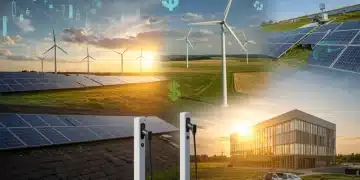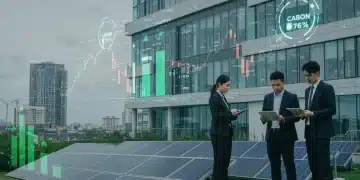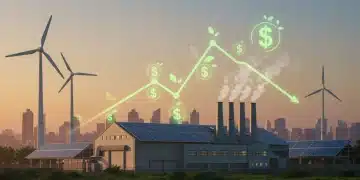Federal vs. State Environmental Incentives: Maximize Green Investments 2025
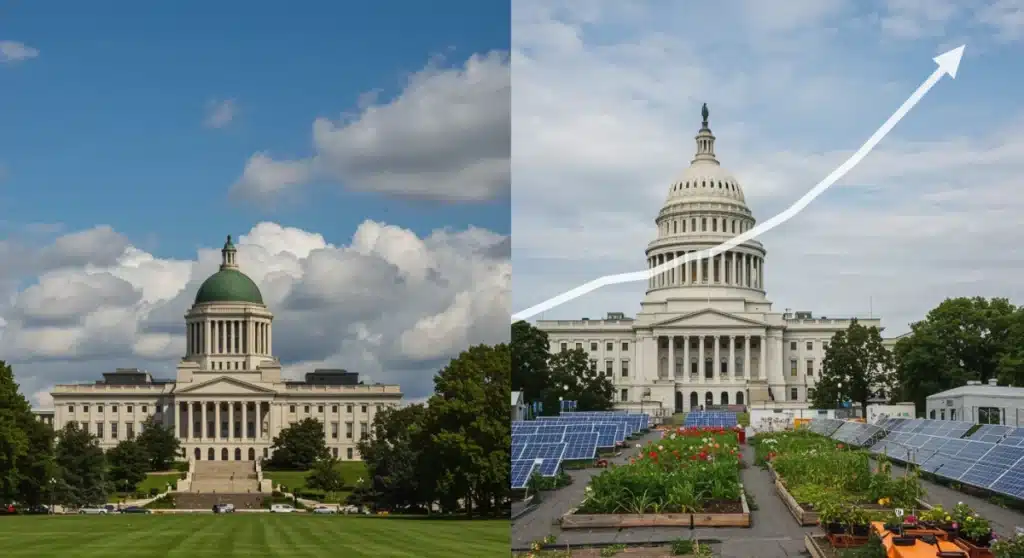
Understanding the nuanced differences between federal and state environmental incentives is crucial for maximizing green investments in 2025, directly impacting financial returns and sustainable project viability.
As 2025 approaches, individuals and businesses are increasingly seeking ways to leverage sustainable practices for both environmental benefit and financial gain. The landscape of support for such initiatives is complex, primarily divided between federal and state programs. Navigating and understanding comparing federal vs. state environmental incentives is paramount for maximizing your green investments in the coming year, offering a critical pathway to optimize financial impact and accelerate sustainability goals.
Understanding the Federal Environmental Incentive Landscape
The federal government plays a significant role in promoting environmental sustainability through a broad array of incentives. These programs are typically designed to address large-scale environmental challenges, foster national economic growth in green sectors, and set overarching policy directions. Recent developments continue to expand and refine these offerings, making it imperative for investors to stay informed.
Federal incentives often come in the form of substantial tax credits, grants, and loan programs aimed at renewable energy development, energy efficiency upgrades, and sustainable agriculture. These initiatives are generally consistent across all states, providing a foundational layer of support for green projects nationwide. The Inflation Reduction Act (IRA), for instance, significantly bolstered many of these federal programs, offering long-term certainty for investors.
Key Federal Program Categories
- Renewable Energy Tax Credits: Investment Tax Credits (ITC) and Production Tax Credits (PTC) for solar, wind, geothermal, and other clean energy technologies.
- Energy Efficiency Rebates: Programs like those under the IRA providing homeowner rebates for electric appliances and energy-efficient home improvements.
- Clean Vehicle Incentives: Tax credits for purchasing new and used electric vehicles, encouraging adoption and reducing emissions.
- Sustainable Agriculture Grants: Funding for practices that enhance soil health, reduce water usage, and promote biodiversity.
These federal mechanisms are critical for driving market adoption of green technologies and practices. They often require adherence to specific labor standards, domestic content requirements, or environmental impact assessments, reflecting broader national policy objectives.
Exploring State-Specific Environmental Incentives
While federal incentives provide a national baseline, state-level environmental incentives offer a crucial layer of localized support and often fill gaps or enhance federal programs. States frequently tailor their incentives to address unique regional environmental challenges, economic development goals, and energy portfolios. This localized approach means that a comprehensive understanding requires delving into specific state policies.
State incentives can vary widely, ranging from additional tax credits and property tax exemptions to direct grants, low-interest loans, and innovative regulatory frameworks such as Renewable Portfolio Standards (RPS). These state-specific programs can significantly alter the financial viability of a green project, making a project highly attractive in one state while less so in another. As of late 2024, many states are actively revising their incentive structures to complement or leverage the expanded federal offerings.
Diverse State Incentive Types
- State Tax Credits and Exemptions: Additional credits for solar installations, electric vehicle charging infrastructure, or energy-efficient building construction.
- Grant Programs: Funding for local clean energy projects, community-based conservation efforts, and environmental justice initiatives.
- Rebate Programs: State-funded rebates for specific energy-efficient appliances or renewable energy systems, often stackable with federal rebates.
- Regulatory Support: Policies like net metering, carbon pricing, and clean energy mandates that create market demand and financial opportunities.
The variability in state incentives underscores the importance of a detailed, location-specific analysis for any green investment. What works in California, with its aggressive renewable energy targets, might differ substantially from incentives available in Texas, which focuses heavily on wind energy development.
Comparing Financial Impact: Federal vs. State Stacking
The true power of environmental incentives often lies in their ability to be combined, or ‘stacked,’ to maximize financial returns. Understanding how federal and state incentives interact is a critical strategy for maximizing your 2025 green investments. Many state programs are designed to be complementary to federal ones, allowing projects to benefit from multiple layers of financial support.
For instance, a solar installation project might qualify for a significant federal Investment Tax Credit (ITC) and then also be eligible for a state-level tax credit, a local property tax exemption, and a utility rebate. This stacking can dramatically reduce the upfront cost of a project and improve its long-term financial performance. However, there are instances where state and federal incentives cannot be combined, or where one might reduce the value of the other, necessitating careful planning.
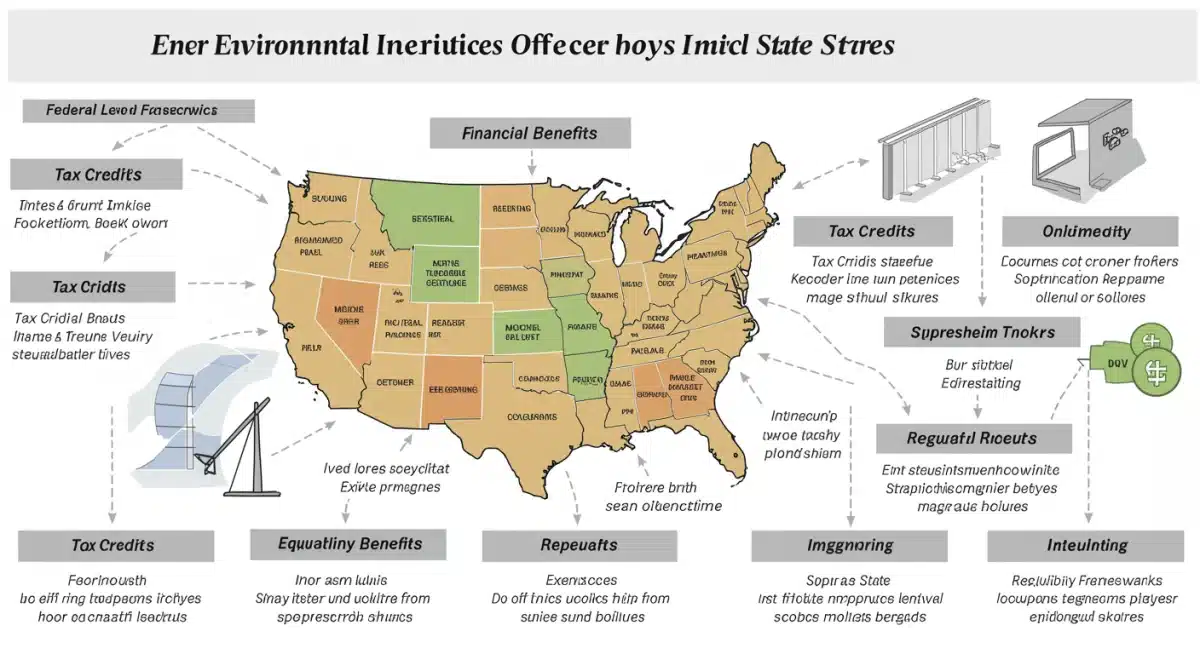
Investors must conduct thorough due diligence to identify all applicable incentives and understand their stacking potential. This often involves consulting with financial advisors specializing in green investments and staying updated on the latest policy changes at both levels of government. The strategic combination of these incentives can be the difference between a marginally profitable project and a highly lucrative one.
Strategic Considerations for 2025 Green Investments
As we look towards 2025, strategic planning for green investments must incorporate a detailed analysis of both federal and state environmental incentives. The dynamic nature of these policies means that what was true last year may not hold for the upcoming period. Investors should prioritize flexibility and adaptability in their investment strategies.
A key consideration is the long-term stability of incentive programs. Federal programs, especially those codified through significant legislation like the IRA, tend to offer greater predictability over several years. State programs, while often robust, can be more susceptible to changes in state budgets, political leadership, and local economic conditions. Diversifying green investments across different states or project types can mitigate some of this risk.
Maximizing Investment Returns
- Early Adoption: Many incentives are designed to encourage early adoption, with benefits potentially decreasing over time as technologies mature.
- Local Expertise: Engaging with local economic development agencies and environmental organizations can uncover lesser-known state or municipal incentives.
- Policy Tracking: Continuously monitor legislative updates at both federal and state levels to identify new opportunities or potential changes to existing programs.
Furthermore, understanding the specific eligibility requirements for each incentive is crucial. These can include project size, technology type, location, and even social equity considerations. Missing a single requirement can disqualify a project from significant financial benefits, highlighting the need for meticulous application processes.
Navigating Regulatory Frameworks and Compliance
Beyond direct financial incentives, both federal and state governments establish regulatory frameworks that significantly influence green investments. These regulations can mandate certain environmental standards, create markets for renewable energy, or impose penalties for non-compliance, all of which impact the financial landscape for sustainable projects.
Federal regulations, such as those from the Environmental Protection Agency (EPA), often set national standards for air and water quality, hazardous waste, and emissions. These regulations can drive demand for technologies and services that help businesses comply, thereby creating investment opportunities. State environmental agencies then often implement and enforce these federal standards, sometimes adding stricter requirements based on local conditions.
The interaction between federal and state regulations can be complex. For example, a federal mandate for reduced carbon emissions might be met by a state through a cap-and-trade program, a renewable energy mandate, or a combination of policies. Investors must understand these intertwined regulatory environments to accurately assess risks and opportunities associated with their green projects.
Key Regulatory Influences
- Emission Standards: Federal and state limits on pollutants, driving investment in cleaner production technologies.
- Renewable Portfolio Standards (RPS): State mandates requiring utilities to source a certain percentage of their electricity from renewable sources, creating a stable market for clean energy.
- Permitting Processes: Environmental impact assessments and permitting requirements at both levels of government can influence project timelines and costs.
Compliance with these regulatory frameworks is not just about avoiding penalties; it can also unlock additional incentives or make projects more appealing to environmentally conscious investors. A clear understanding of the regulatory landscape is as vital as the financial incentives themselves when planning for 2025 green investments.
Case Studies: Federal and State Incentive Successes
Examining successful projects that have effectively leveraged both federal and state environmental incentives provides valuable insights for future green investments. These case studies often highlight the strategic combination of different programs and the importance of localized knowledge. Recent examples demonstrate the substantial financial impact achievable through careful planning.
One notable example includes large-scale utility solar farms that have utilized federal Investment Tax Credits alongside state-specific Renewable Energy Credits (RECs) and property tax abatements. This multi-layered approach has allowed developers to achieve lower project costs, secure financing more easily, and offer competitive electricity prices. The success of these projects is often contingent on expert navigation of complex application processes and timelines for both federal and state programs.
Another area of success is in energy efficiency upgrades for commercial buildings. Businesses have combined federal tax deductions for energy-efficient commercial buildings (179D) with state-level rebates for HVAC system replacements and LED lighting retrofits. These combined incentives significantly reduce the payback period for such investments, making them highly attractive to building owners seeking to cut operational costs and improve their environmental footprint.
Lessons from Successful Projects
- Integrated Planning: Success stories consistently show projects that planned for both federal and state incentives from inception.
- Financial Modeling: Detailed financial models that account for all applicable incentives are crucial for demonstrating project viability.
- Community Engagement: Some state and local incentives prioritize projects with community benefits, making engagement a key factor for securing support.
These examples underscore that while the array of incentives can seem daunting, the potential for significant financial and environmental returns is substantial for those who meticulously plan and execute their green investment strategies. The 2025 outlook suggests continued growth in these areas, presenting ongoing opportunities for informed investors.
| Key Aspect | Brief Description |
|---|---|
| Federal Incentives | Broad tax credits and grants, national scope, foundational support for large-scale green projects. |
| State Incentives | Localized tax credits, rebates, and regulatory support, tailored to regional needs and often stackable. |
| Financial Stacking | Combining federal and state incentives to maximize financial returns and project viability. |
| Regulatory Impact | Federal and state regulations influence project demand, compliance costs, and market opportunities. |
Frequently Asked Questions About Green Investments
Federal incentives, like tax credits under the IRA, typically apply nationwide for broad goals such as renewable energy. State incentives are localized, tailored to specific regional needs, and can include additional tax breaks, grants, or rebates, often complementing federal programs.
Yes, many federal and state incentives are designed to be ‘stackable,’ allowing investors to combine them for greater financial benefits. This stacking can significantly reduce project costs and enhance overall returns, though some restrictions may apply.
Eligibility often covers a wide range of projects, including solar and wind energy, energy-efficient home and commercial upgrades, electric vehicle purchases, sustainable agriculture, and various conservation efforts. Specific criteria vary by program and location.
Consult state energy offices, environmental protection agencies, and local utility providers. Websites like DSIRE (Database of State Incentives for Renewables & Efficiency) are excellent resources for comprehensive, up-to-date information on state-specific programs.
The outlook remains positive, with strong bipartisan support for many green initiatives. Federal programs offer stability, while states continue to innovate. Investors should anticipate ongoing evolution in incentives, requiring continuous monitoring and adaptive strategies.
Looking Ahead: Maximizing Green Investment Opportunities
The landscape of environmental incentives, both federal and state, is continuously evolving. For 2025, the critical takeaway for investors and individuals alike is the necessity of a proactive and informed approach. The interplay between national policies and localized state programs creates a complex yet fertile ground for maximizing green investments. Staying abreast of legislative changes, understanding specific eligibility criteria, and strategically combining available incentives will be key to unlocking significant financial and environmental returns. The push towards a greener economy is accelerating, and those who master the art of navigating these incentives stand to gain the most.

